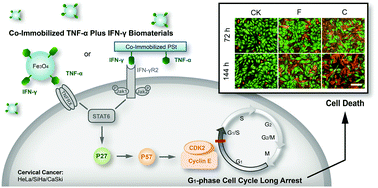Long-term G1 cell cycle arrest in cervical cancer cells induced by co-immobilized TNF-α plus IFN-γ polymeric drugs†
Abstract
A realistic control of cell cycle arrest is an attractive goal for the development of new effective anti-cancer drugs. Any clinical application of an effective anti-cancer drug necessarily relies on the understanding of cellular interaction mechanisms. In the present study, we prepared a co-immobilized TNF-α plus IFN-γ biomaterial, which showed a significant inhibition effect on cervical cancer cell growth, as demonstrated by a series of structural and cellular characterizations. We found that co-immobilized TNF-α plus IFN-α induced a long-term G1 phase cell cycle arrest in HeLa, SiHa, and CaSki cells, respectively. More surprisingly, the expression level of the p27 protein decreased, even when p27 mRNA was highly expressed. In addition, gene-chip results and microarray analysis showed that p57 may be downstream from p27, which acts as a direct regulator of the long-term G1 cell cycle arrest in these cells, leaving no escape for cervical cancer cells. Finally, we also investigated the anti-tumor mechanism of co-immobilized TNF-α plus IFN-γ in vivo, using a nude mice animal model. To sum up, our findings suggested that the co-immobilized TNF-α plus IFN-γ can induce a long-term cell cycle arrest in cancer, thus serving as a very efficient tool for treating cervical cancer.



 Please wait while we load your content...
Please wait while we load your content...